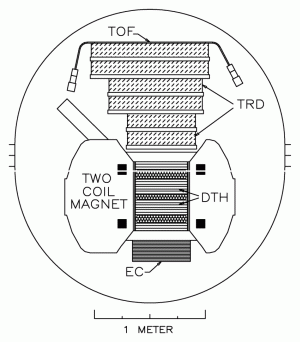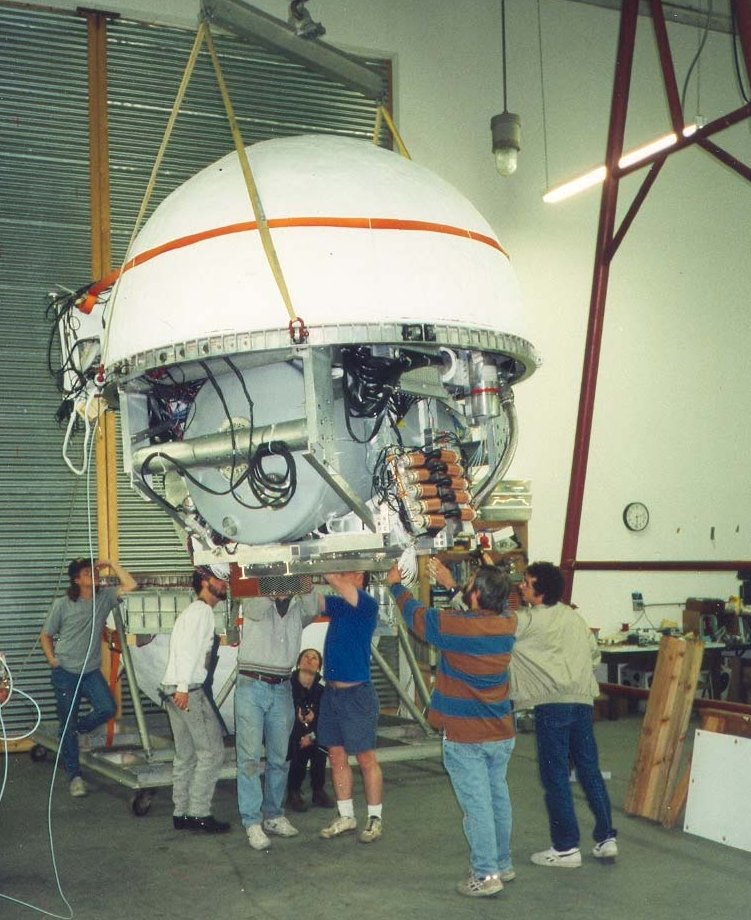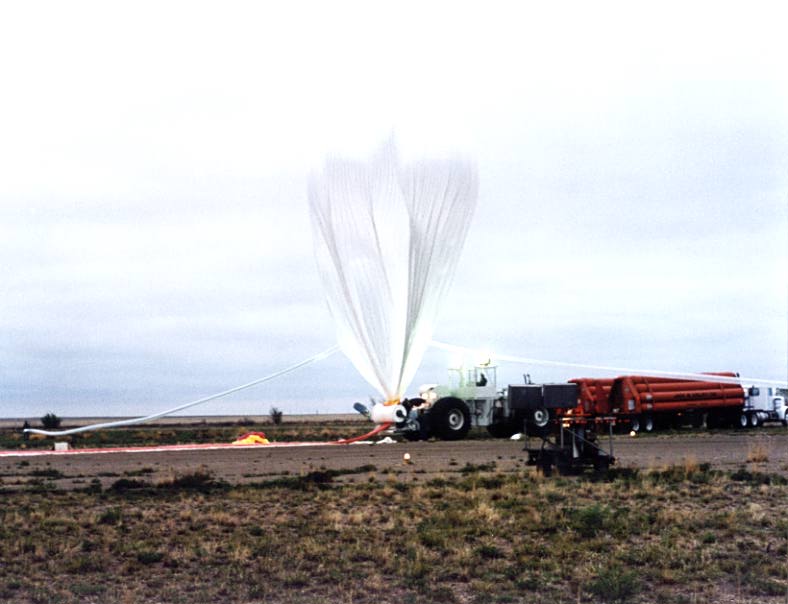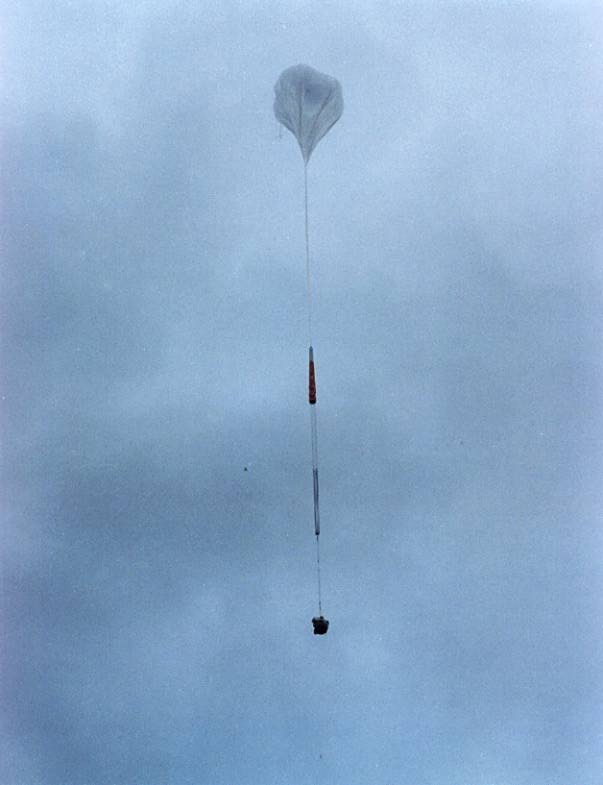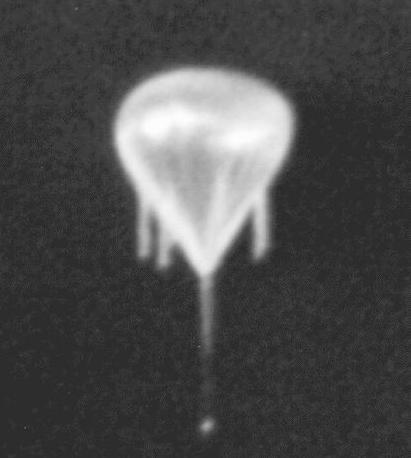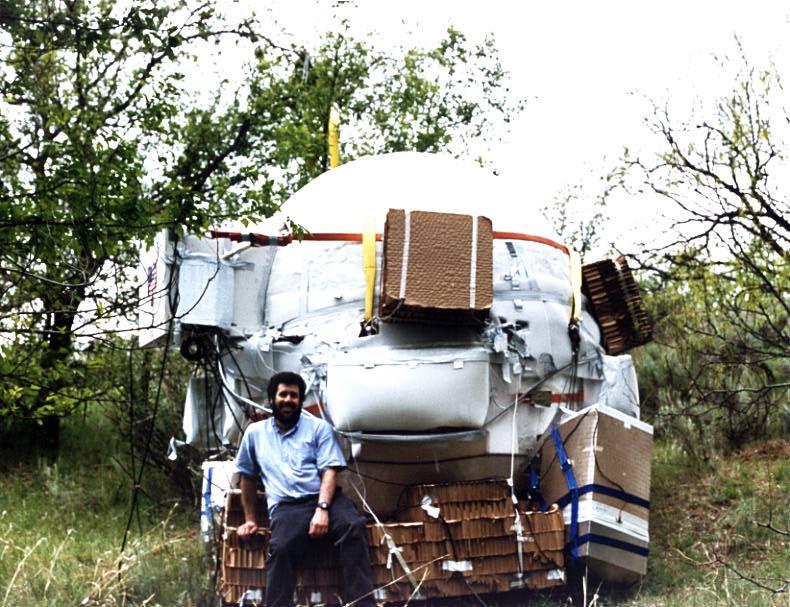Purpose of the flight and payload description
An instrument optimized for the detection and identification of cosmic-ray electrons and positrons at energies from about 1 GeV up to 50 GeV and beyond. It consists of a two-coil superconducting magnet and a precision drift-tube tracking hodoscope, complemented with a time-of-flight system, a transition radiation detector and an electromagnetic shower counter.
The superconducting magnet, with two circular Niobium-Titanium coils held at 4.2 K in a liquid-helium bath, provides an approximately uniform field of about 1 Tesla within a rectangular room-temperature bore measuring 51 cm x 51 cm x 61 cm. The cryostat employs a vapor-cooled radiation shield and superinsulation to isolate the inner helium vessel from the ~300 K environment. The total liquid helium capacity for the system is 260 liters, with a maximum hold time of ~7 days. The total system weight is 420 kg.
The drift-tube hodoscope (DTH) consists of 479 thin-walled drift tubes, each 2.45 cm in diameter, arrayed in 26 layers. Of these, 18 layers are aligned with the tube axes parallel to the magnetic field, and provide trajectory measurements used to determine rigidity. The remaining 8 layers, aligned with axes normal to the magnetic field, provide the additional information required to reconstruct trajectories in three dimensions. A drift gas based on CO2 with hexane as an organic quencher flows through the tubes. CO2 is used because it exhibits low diffusion as well as a slow drift speed. This ensures the minimum possible broadening of the electron cloud as it drifts towards the sense wire, resulting in improved single-point tracking resolution.
The hodoscope electronics are designed to measure the difference in time between the detection of an ionizing particle in a drift tube and a STOP pulse generated by the experiment trigger. The timing measurement represents the drift time for the first electrons produced by the ionizing particle that reach the anode wire, and corresponds to the distance of closest approach to the anode wire for the ionizing particle.
Given the large backgrounds present against the cosmic positron signal, mostly due to cosmic rays (CR) protons more abundant, or stray particles from the isotropic CR flux that enter the instrument from outside its field of view, a strong background rejection power is necessary. In the HEAT instrument this is done by combining the magnet spectrometer with a time-of-flight (TOF) system, a transition radiation detector and an electromagnetic shower counter, thus attaining an adecquate level of proton rejection.
The TOF system consists of four scintillators at the top of the instrument (each 100 cm x 25 cm x 1 cm) and the top three scintillator layers of the electromagnetic shower counter (each 50 cm x 50 cm x 1 cm). HEAT use Hamamatsu photomultiplier tubes (PMTs), which can be oriented along the fringe fields of the magnet such that gain losses are minimized. PMT anode signals are amplified and provide the experiment fast trigger (top-bottom coincidence) and are time and charge-digitized.
The particle's velocity is determined from the time-of-flight, utilizing the path length through the instrument obtained by extrapolation of the drift-tube track in the precisely known magnetic field. It's magnitude is determined by correcting the measured energy loss (proportional to the charge collected at the PMT anodes) in the top TOF counters.
A transition radiation detector (TRD) is particularly well-suited to discriminate between electrons and hadrons throughout the energy interval addressed by HEAT, where electrons and positrons produce saturated TR signals, while protons produce no TR.
The TRD is comprised of six modules, each consisting of a 12.7 cm-thick polyethylene fiber radiator viewed by a 2 cm-thick multiwire proportional chamber (MWPC). A gas mixture of 70% xenon and 30% methane flows through the MWPCs, for an efficient detection of TR photons, yet providing an ionization signal that does not dominate over the TR signal. Stretched aluminized mylar sheets provide cathode windows in which the aluminum is etched to form 7.8 cm-wide cathode "strips". The total charge deposited on these strips, and hence the total energy deposited in the MWPC, is pulse-height analyzed with 12-bit resolution.
Finally the electromagnetic shower counter (EC) is used to measure the electron energy and to complement the hadron rejection capability of the TRD (besides providing the bottom TOF measurement). The EC consists of 10 layers of 0.5 em-thick lead sheets (0.9 radiation length) interleaved with scintillator slabs (50 cm x 50 cm x 1 cm). The PMT anode outputs are fed into two pulse-height analysis and digitization chains operating at different gains. EC signals are used as part of the trigger system, where for a settable fraction of events, a minimum shower sum is required.
Details of the balloon flight

Balloon launched on: 5/3/1994 at 13:13 utc
Launch site: Scientific Flight Balloon Facility, Fort Sumner, (NM), US
Balloon launched by: National Scientific Balloon Facility (NSBF)
Balloon manufacturer/size/composition: Zero Pressure Balloon SF3-459.37-080-NSXCHR-ST
Balloon serial number: W39.57-3-04
Flight identification number: 377N
End of flight (L for landing time, W for last contact, otherwise termination time): 5/4/1994 at 13:13 utc
Balloon flight duration (F: time at float only, otherwise total flight time in d:days / h:hours or m:minutes - ): F 26 h
Landing site: 6 miles W of Wellington, Texas, US
The balloon was launched by dynamic method with assistance of launch vehicle (Big Bill) on May 3, 1994.
After an initial ascent phase, the balloon reached float altitude (between 110,000 and 120,000 feet) and remained more or less at that same altitude allowing the scientific team to obtain about 32 hours of useful data. At the end of the flight, the termination command was sent but the separation device failed and the parachute remained tied to the bottom of the balloon. As the gas bag was in an unknown state NSBF authorities decided not to take the risk to let it fly over populated areas, but the only way to end the mission was to separate the payload from the parachute and let it fall free to destruction on a desert area.
During all the night, the balloon remained close to Amarillo, Texas, but never reached the city. Finally the balloon was valved down and the detector landed safely in the Eastern portion of the Texas panhandle, near the city of Wellington, where it was recovered by a ground crew.
This was the first balloon flight of the instrument. Data were collected at float altitude for about 29 hours. The payload reached a maximum altitude of 36.5 km and descended to a minimum of 33 km at night. This corresponds to a mean atmospheric overburden of 5.7 g/cm2. The payload floated between vertical geomagnetic cutoff rigidities of 4 GV and 4.5 GV performing as expected.
External references
- Air Shower Muons and the Atmospheric Neutrino Puzzle 26th International Cosmic Ray Conference. Vol. 2, p.68
- Cosmic Antimatter article published on Scientific American, April 1998 - PDF format -
- Cosmic Ray Positrons at High Energies: A New Measurement Phys.Rev.Lett. 75 (1995) 390-393
- Cosmic-Ray Positrons: Are There Primary Sources? Astropart.Phys. 11 (1999) 429-435
- Electron and positron energy spectra: HEAT magnet spectrometer results 26th International Cosmic Ray Conference. August 17-25, 1999. Salt Lake City, Utah, USA
- High-Energy Antimatter Telescope (HEAT): Basic Design and Performance at CiteSeer
- Measurements Of The Cosmic Ray Positron Fraction With The Heat Spectrometer at CiteSeer
- Measurements of the Cosmic-Ray Positron Fraction From 1 to 50 GeV at CERN
- NASA Balloon Flights (1989-1998) in NASA Historical Data Book, Vol. VII: NASA Launch Systems, Space Transportation, Human Spaceflight, and Space Science, 1989-1998
- Secondary And Re-Entrant Albedo Electrons In The Atmosphere at CiteSeer
- The Energy Spectra and Relative Abundances of Electrons and Positrons in the Galactic Cosmic Radiation Astrophys.J. 498 (1998) 779-789
- The WiZard collaboration cosmic ray muon measurements in the atmosphere Nuclear Physics B - Proceedings Supplements - Volume 85, Issues 1-3, May 2000, Pag. 355
622If you consider this website interesting or useful, you can help me to keep it up and running with a small donation to cover the operational costs. Just the equivalent of the price of a cup of coffee helps a lot.

